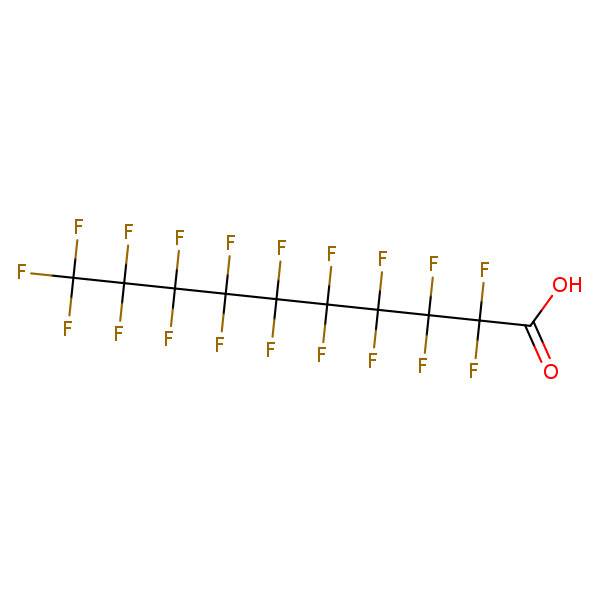Perfluorodecanoic Acid (PFDA)
CASRN 335-76-2 | DTXSID3031860
- IRIS Executive Summary (PDF) (7 pp, 393.6 KB, about PDF)
Toxicological Review of Perfluorodecanoic Acid (PFDA) and Related Salts (Final Report, 2024)
On this page:
Alert
Notice
EPA announced the release of the IRIS Toxicological Review Perfluorodecanoic Acid (PFDA) and Related Salts. The interagency comments on the IRIS Interagency Science Discussion Draft were also released.
Overview
EPA has finalized the IRIS Toxicological Review of Perfluorodecanoic Acid (PFDA) and Related Salts. This assessment addresses the potential cancer and noncancer human health effects from exposure to PFDA and related salts. EPA’s program and regional offices may use this assessment to inform decisions to protect human health.Background
Perfluorodecanoic Acid (PFDA) and its related salts are members of the group of per and polyfluoroalkyl substances (PFAS). PFAS are not naturally occurring in the environment; they are man-made compounds that have been used widely over the past several decades in consumer products and industrial applications because of their resistance to heat, oil, stains, grease, and water. Concerns about PFDA and other PFAS stem from the resistance of these compounds to hydrolysis, photolysis, and biodegradation, which leads to their persistence in the environment. PFDA has been used in stain and grease-proof coatings on food packaging, furniture, upholstery, and carpet. PFDA has also been detected in nano- and impregnation-sprays, outdoor textiles, carpet, gloves, paper-based food contact materials, ski wax, and leather. Exposure is possible via inhalation of indoor or outdoor air, ingestion of drinking water and food, and dermal contact with PFDA-containing products.| Date | Description |
|---|---|
| Nov 2019 | EPA released the Systematic Review Protocol for the PFAS IRIS Assessment (Preliminary Assessment Materials). [Federal Register Notice Nov 8, 2019] |
| Jul 2020 | EPA released an update to the Systematic Review Protocol for the PFBA, PFHxA, PFHxS, PFNA, and PFDA IRIS Assessments in response to public comments. |
| Mar 2022 | EPA sent an interagency science consultation PFDA draft for review and comment. |
| Apr 2023 | EPA released the draft IRIS Toxicological Review of Perfluorodecanoic Acid (PFDA) and Related Salts for a 60-day public comment period and external peer review. EPA also released the interagency science consultation comments from reviewers. [Federal Register Notice: April 10, 2023 ] |
| Oct 2023 | EPA posted the final peer review report from the contractor on the EPA website. |
| Apr 2024 | EPA submitted the revised interagency science discussion draft for final Agency and Interagency review. |
| Jul 2024 | EPA posted the final report IRIS Toxicological Review of Perfluorodecanoic Acid (PFDA) and Related Salts and released the interagency science discussion draft comments on the IRIS website, and updated key IRIS values for PFDA in the IRIS database. |
Download(s)
This document has been reviewed in accordance with U.S. Environmental Protection Agency policy and approved for publication. Mention of trade names or commercial products does not constitute endorsement or recommendation for use.
- Toxicological Review of Perfluorodecanoic Acid (PFDA) and Related Salts (EPA/635/R-23/027f) (PDF) (221 pp, 13.3 MB, about PDF)
- Toxicological Review of Perfluorodecanoic Acid (PFDA) and Related Salts - Supplemental Information (PDF) (PDF) (310 pp, 5.3 MB, about PDF)
- Toxicological Review of Perfluorodecanoic Acid (PFDA) and Related Salts - Executive Summary (PDF) (PDF) (6 pp, 402.3 KB, about PDF)
If you have a disability and the format of any material on our web pages interferes with your ability to access the information, please reach out to us using the Contact Us about IRIS form for assistance. To enable us to respond in a manner most helpful to you, please indicate the nature of the accessibility problem, the web address of the requested material, your preferred format in which you want to receive the material (electronic format (ASCII, etc.), standard print, large print, etc.), and your contact information.
Document Related Link(s)
- Systematic Review Protocol for the PFAS IRIS Assessments (2021)
- Systematic Review Protocol for the Perfluorodecanoic Acid (Pfda) IRIS Assessments (Preliminary Assessment Materials)
- Toxicological Review of Perfluorodecanoic Acid (Pfda) (Interagency Science Consultation Draft, 2022)
- External Peer Review Activities for PFDA Integrated Risk Information System (IRIS) Assessment (Jul 2023)
- Toxicological Review of Perfluorodecanoic Acid (PFDA) and Related Salts (Interagency Science Discussion Draft, 2024)
Related Links
Critical Effect Systems
Chemical Structure for
Perfluorodecanoic Acid (PFDA)





